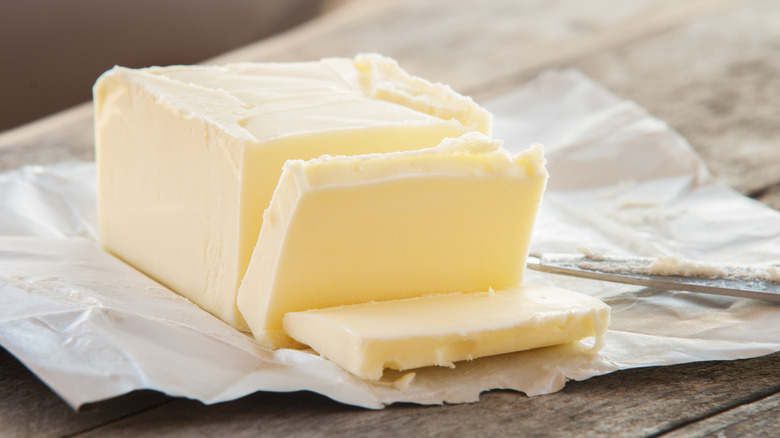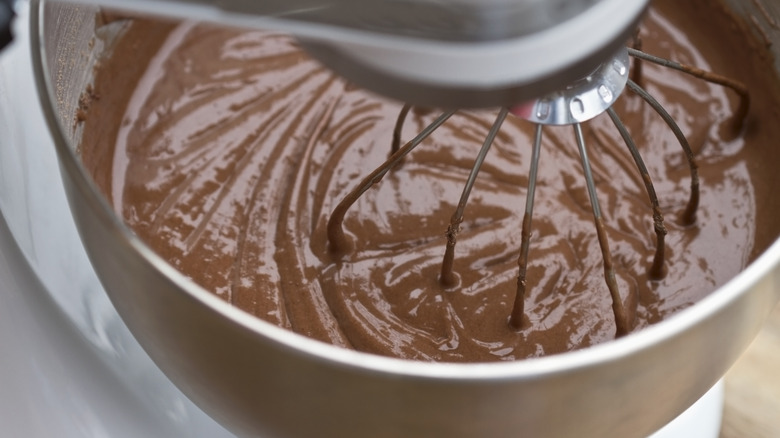Mary Berry's No. 1 Cardinal Rule For Baking Oils
A stroll through the dairy aisle of the grocery store presents an array of different fats and spreads to choose from, with an increasing amount of brands on shelves, including high-quality European butters and buttery sticks and spreads for plant-based eaters. While these varieties are great when it comes to product innovation, when you're choosing what fat to use when baking a cake, the options can be overwhelming. You may wonder what ingredients are right to choose and where can you afford to substitute one fat for another.
As a general rule of thumb in baking, don't reach for low- or reduced-fat versions of "buttery spread." When you're baking a cake, you need the full-fat sticks. Mary Berry, chef, food writer, and former TV co-host of the "Great British Baking Show," opts for real butter and margarine for her cakes. She explained to The Independent in 2011 that low-fat spreads "tend to be full of water."
In fact, full-fat content of butter and margarine plays a key function in the soft and open crumb structure of a cake. Using lower-fat oils can negatively impact the texture and taste of your bakes.
The importance of full-fat baking
The high fat content of butter and margarine (both are at a minimum 80% fat) imparts a mouth-watering, buttery flavor to bakes and is essential for achieving airy, tender cakes with a fine crumb structure.
In cake recipes, such as classic pound cake, softened butter or margarine is typically mixed for a few minutes on medium-high speed with granulated sugar in a stand mixer (or even using a mixing bowl and a wooden spoon) until light, airy and pale yellow in color, in a process called creaming. During the creaming step, sugar crystals pierce little holes in the soft yet pliable butter. Aerating the fat until light and creamy allows it to assume its role of holding onto gasses that are released during baking in the oven, creating rise and levity that's ideal for bakes.
Fat also functions to coat the starches and other ingredients in cake batter, while the remaining liquid portion of butter hydrates the proteins and creates moisture in the batter. The high percentage of fat in butter and margarine also discourages the gluten protein network in wheat flour from over-developing, making cakes lighter in texture and not overly bread-like or dense.
How to choose the right fat for your cakes
Whether you're making a show-stopper birthday cake or a casual sweet treat to enjoy over the course of your week, the ratio of fat to liquid in your baking oil is important. When baking a cake, always go for full-fat versions of butter, or use margarine for a plant-based option.
In butter, fat levels can range from 80-85% fat. (For even great flavor in your bakes, splurge on European high-quality butters, which typically have a fat content on the higher end of that range.) Like butter, margarine has a minimum 80% fat content, so it will uphold the functionality of buttery fats in your cake. Though it was popularized in the '80s and '90s as a heart-healthy alternative to butter due the unsaturated fat content of plant oils, such as soybean and canola, margarine has been a stable, plant-based baking fat and dairy alternative for years.
Unlike butter and margarine, however, low-fat buttery spreads replace much of the fat with water, as well as ingredients that stabilize the mixture to a semi-solid, spreadable state. Avoid using these low-fat spreads in cakes and other bakes, as the extra moisture they contain will over-hydrate your batter and make cakes that are overly dense. Due to their higher water content, low-fat spreads don't aerate as well and will melt easier when agitated in the creaming step, resulting in undesirably flat bakes.


